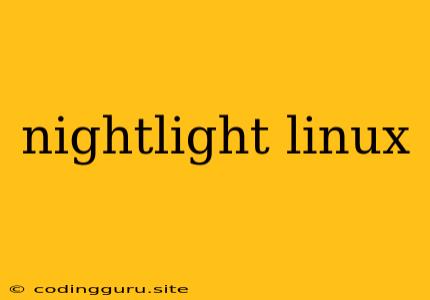Illuminating Your Night with Nightlight on Linux
Ever found yourself staring at your computer screen late into the night, only to feel the strain on your eyes and the disruption of your sleep cycle? This is a common problem, especially in today's digital world. The blue light emitted from your computer screen can interfere with your body's natural melatonin production, making it harder to fall asleep. This is where Nightlight comes in, a powerful tool built into most Linux distributions.
Nightlight is a built-in feature that reduces the amount of blue light emitted from your screen, creating a warmer, more soothing glow. This can help to reduce eye strain, improve your sleep quality, and even make your screen more comfortable to use in low-light conditions.
Why Use Nightlight?
Let's explore the benefits of incorporating Nightlight into your daily routine:
- Reduces Eye Strain: The blue light emitted from digital devices can cause eye fatigue, dryness, and headaches. Nightlight filters out this blue light, making your screen easier on your eyes, especially during extended use.
- Improves Sleep Quality: Blue light suppresses the production of melatonin, a hormone that regulates your sleep-wake cycle. By reducing blue light exposure, Nightlight helps your body naturally produce melatonin, promoting better sleep.
- Creates a More Relaxing Viewing Experience: The warmer tones of Nightlight can create a more comfortable and relaxing viewing experience, especially in dimly lit environments.
Activating Nightlight on Linux
Nightlight is often integrated into the display settings of most popular Linux distributions. Here's a general guide to activating Nightlight on your system:
- Open System Settings: Find the system settings app on your desktop, typically represented by an icon depicting a cogwheel or gear.
- Navigate to Display Settings: Look for a section related to "Display," "Screen," or "Monitor."
- Locate Nightlight: Within the display settings, search for an option titled "Nightlight," "Blue Light Filter," or something similar.
- Enable Nightlight: Toggle the switch or checkbox to activate Nightlight.
- Customize Settings: Most Nightlight features allow you to adjust the intensity, color temperature, and scheduling. Experiment with different settings to find what works best for you.
Examples of Nightlight Implementation
Here are a few examples of how Nightlight is implemented in different Linux distributions:
- Ubuntu/GNOME: Nightlight is accessible from the "Display & Brightness" section in the system settings app. You can adjust the color temperature and schedule for activation.
- KDE Plasma: Nightlight is found in the "System Settings" app under the "Display & Monitor" category. You can customize the intensity, color temperature, and schedule.
- XFCE: Nightlight may be integrated into the "Display Settings" or available as a separate package to install.
Beyond the Basics: Advanced Nightlight Features
While Nightlight is generally straightforward to use, many Linux distributions offer more advanced features:
- Automatic Scheduling: Schedule Nightlight to activate at a specific time, like sunset, or turn it on during specific hours.
- Color Temperature Adjustment: Adjust the color temperature to your liking, from a cool blue to a warm orange. This gives you greater control over the overall appearance of your screen.
- Intensity Control: Fine-tune the intensity of the Nightlight effect, allowing you to reduce blue light exposure gradually or to a greater degree depending on your needs.
- Integration with Other Apps: Some systems integrate Nightlight with other apps, such as task managers, to automatically activate it during certain tasks or workflows.
Nightlight: A Boon for Digital Well-being
Nightlight is a simple yet powerful tool that can significantly improve your digital well-being. By reducing blue light exposure, it helps to alleviate eye strain, promote better sleep, and create a more comfortable viewing experience. Incorporating Nightlight into your routine can lead to a healthier relationship with your digital devices.
Conclusion
Nightlight is a valuable feature built into most Linux distributions. It allows you to reduce blue light exposure from your screen, improving your eye comfort, sleep quality, and overall digital well-being. By understanding the benefits of Nightlight and exploring its advanced features, you can personalize your digital experience and enhance your health in the process.
